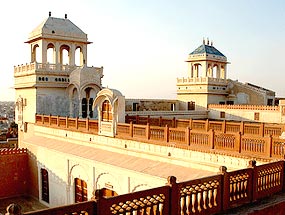Junagarh Fort is the priced possession of the
Bikaner city of Rajasthan. With this article, we try to explore
Junagarh Fort of Rajasthan, India.
Junagarh Fort

Location: Bikaner, Rajasthan
Founded By: Raja Rai Singh
Founded In: Between 1589 and 1594
Timings: 10:00 am to 5:00 pm (Daily)
Junagarh Fort is situated in the Bikaner city of Rajasthan, quite near
the public park. The fort is a splendid piece of architecture and is
adorned with towers that seem to be soaring into the sky. Junagarh Fort
was built under the aegis of Raja Rai Singh, a general in the army of
the Mughal Emperor Akbar. The foundation of the fort was laid down in
the year 1589 and it took approximately 5 years to complete the
monument. Enclosing the Junagarh fort of India is a wall that is almost
986 meters in length.
A series of thirty-seven pavilions festoon the fort, which comprises of
a number of palaces inside its complex. Apart from that, there are also
several public court buildings and intimate zenanas (women's quarters)
inside it. The zenanas were meant to hide the women of the court from
the vision of the courtiers. The interiors of the Junagarh fort have
been ornamented with beautiful Rajput paintings, amazing mirror-work and
awe-inspiring lacquer-work. Windows and balconies, arranged in a series,
lend the fort a domestic character.
The picturesque location of Junagarh Fort adds to its beauty and
splendor. One of the few forts in Rajasthan to be built on plain land,
it remained unconquered for close to 400 years. One of the reasons for
this was its setting, which helped the fort in blending with the sandy
desert, thus providing it with a natural camouflage. One of the most
exquisite features of the Junagarh Fort is a raised platforms made of
swords. The fakirs used to dance barefoot on this platform. Then, there
is well inside the complex, which is approximately 450 feet deep.
The excellent library of the fort has a rich compilation of Persian
manuscripts and ancient Sanskrit books, along with an impressive armory.
There are two main entrances to the Junagarh Fort of Rajasthan. One of
them is known as Karan Pol and it lies in the east, while the other is
Chand Pol and it lies in the west. The moment you step in through the
Karan Pol, the first sight that comes across is that of the Sati
Sthambs, imprinted with symbolic hands of the royal ladies who committed
the act of sati.
More sati symbols can be found on the left side of the next gate, which
is called the Daulat Pol. From Daulat Pol, one reaches the Fateh Pol.
All these gates have been equipped with heavy wooden doors, which have
iron plating. Before the other gates were built, the main entrance to
the fort used to be provided by the Suraj Pol, the Sun Gate. The other
gateways are believed to have been built under the reign of Maharaja Gaj
Singh. In front of the Suraj Pol lies the courtyard that houses the
Joramal Temple.
On crossing the Suraj Pol, one comes across the statues of Jaimal and
Patta, seated on top of elephants. Both of them were teenage generals in
Maharana Udai Singh's army and fought fearlessly during the annexation
of Chittor fort. These statues are believed to serve as the guardians of
the fort. Different rulers added different structures to the Junagarh
fort. The last structure, being the new majestic staircase, was added by
Maharaja Ganga Singh. The stone carvings adorning the fort and palaces
lend it a great degree of magnificence.
The numerous palaces, temples and pavilions of the Junagarh fort are
built in red sandstone and have exquisitely carved windows, balconies,
towers and kiosks. One must not miss the Moon Palace, which is decorated
with mirrors, paintings and carved marble panels. The Phool Mahal,
Flower Palace, is adorned with glasses and mirrors. Then, we have the
Karan Mahal, built in the commemoration of the victory over Aurangzeb.
Anup Mahal is a multi-storied palace, used as the power chambers by the
rulers.
The brilliantly preserved rooms of the Anup Mahal today exhibit the
treasures belonging to the Royal family. One must also visit the Ganga
Niwas, Dungar Niwas, Vijai Mahal, and Rang Mahal. There is also a museum
in the Junagarh fort. This museum houses an impressive collection,
comprising of illuminated manuscripts, jewelry, jars, carpets, arms and
weapons, treaties, decorations and 'Farmans'.


